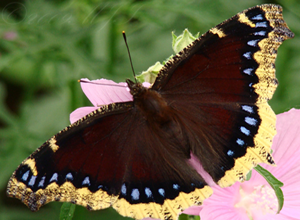The Mourning Cloak is surprisingly active on winter days in the desert.
Photo Credit: MJIphotos via flickr
Nymphalis antiopa
Common Name: mourning cloak
Other Common Names: chenille épineuse de l'orme, morio, mourningcloak, mourningcloak butterfly, spiny elm caterpillar
Animal Guild: Insect
Class > Order > Family: Insecta > Lepidoptera > Nymphalidae
